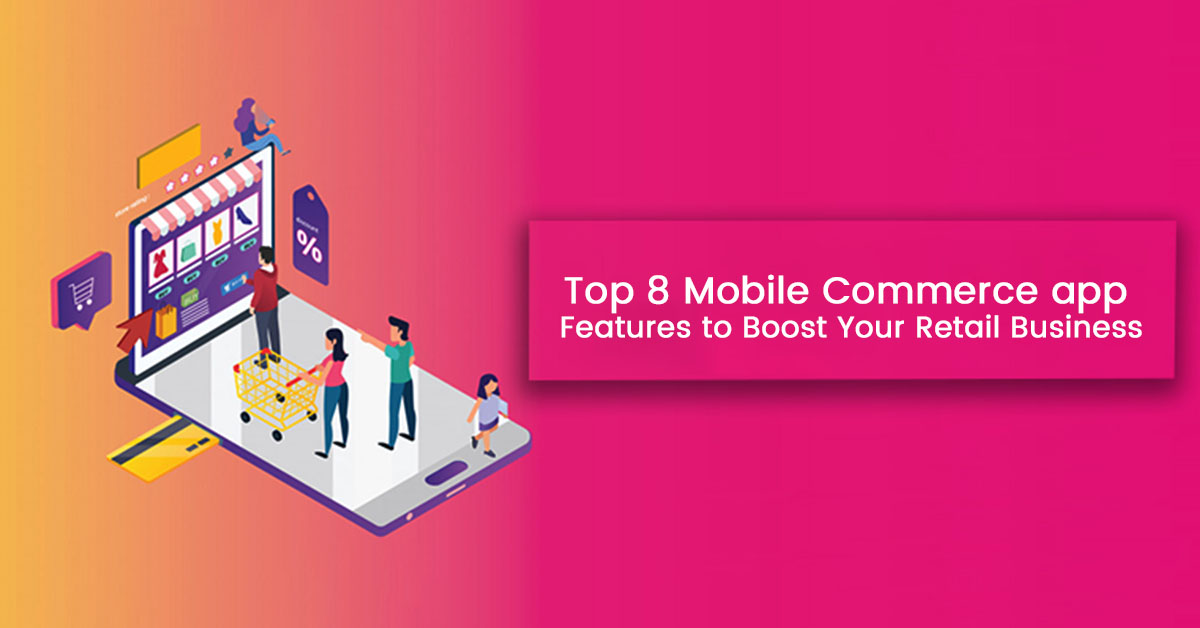Top 8 Mobile E-Commerce app Features to Boost Your Retail Business

Top 8 Mobile Commerce app Features to Boost Your Retail Business
Do you want to create an E-commerce mobile application that will increase your retail, build customer loyalty, and sales and give your business a competitive edge? Check out our list of the top 8 Mobile E-Commerce app features that will help you achieve these goals and make users fall in love with your Mobile E-Commerce app!
1. Product evaluation: While previews are more than common for online shopping, they can be useful for brick-and-mortar stores as well. For example, a client may want to see what the item looks like unboxed, but the store cannot afford to damage the package and has no live model on site. Mobile app developers can create a retail mobile app that would offer different types of product previews: from a static visual preview or video to a 3D or even AR-like model.
Even more convenient, the application can also display other customers’ impressions of the product. Thus, when shopping in the store, the client can not only see a preview of the item he wants to buy but also go through the comments left by customers who have already bought it.
2. Scan the code: Using the camera lens, the retail mobile app can scan the barcode or QR code of any product in the store. Once the code is instantly recognized and the item is found in the database, the app displays additional information about the product, including price, previews, customer impressions, current special offers and remaining quantity. Thanks to this feature, both the retailer and the customer reduce the effort of pre-sales advice.
3. Mobile payment: Of course, a customer can use mobile payment to buy a product in a virtual store only to come to the physical one and pick it up. However, customers can also use mobile payment as a checkout after placing all the desired items in the actual cart at the brick-and-mortar store. This feature helps buyers and retailers save time and avoid long queues.
4. Running Promotion: Retail store apps offer convenience for creating and using coupons. First, coupons can be personalized to the user based on their purchase or (if the user opts in to share some of their personal information) mobile search history. Second, with or without personalization, creating and running special offers for a mobile app takes little time and money for retailers. Finally, the user only needs his mobile app to activate the coupon: he can either show it on the screen to the cashier or press the button to activate the discount for mobile payment.
5. Optimized product images: A brief product description is only the first step. In addition, attention should be paid to optimizing the image of the product displayed on the phone. Since online products cannot be touched or smelled, images play a vital role in e-commerce purchasing decisions. A product page with too few or incorrect images will prevent a customer from making a purchase decision.
Not to mention that, unlike a desktop, a mobile has weaker hardware and often connects to the Internet of Things via Wi-Fi or paid internet services like 3G, and 4G. A product page with optimized images significantly reduces page load time. We currently recommend web as an optimized format to achieve a lightweight image with good image quality. In addition to capacity optimization, your app also needs other convenient features like zoom images, 360-degree photo viewing, etc.
6. Push notifications: When used correctly, push notifications can lead to increased engagement, lifetime, and usage of your mobile app. Conversely, misuse of notifications can cause customers to permanently delete your app from their phones.
Like email marketing, push notifications are used to announce new products and news, such as discounts, promotions, updates, or flash sales events. However, unlike email, you should only choose E-commerce push notifications to display the most compelling and performing offers to avoid distractions. Early notice can lead to an immediate closing of the sale.
7. Product search: No customer wants to manually search for products in a catalog with tens, hundreds or thousands of items. No matter how many products you offer for sale, product search is a vital feature. Make sure your mobile app has an advanced search feature with a filter system. You should also make sure that the search function works efficiently and delivers the relevant results that customers want.
8. Flashdiscounts and offers: You should often be the one giving your customers a reason to buy. A small discount coupon that appears via a push notification on the phone will encourage your customers to interact with the app or make a new purchase. Though data its reveled that 65% of consumers have received exclusive offers, deals, and discounts through mobile e-commerce apps.
Conclusion:
You can’t build an app and forget about it. There is always room for improvement. As a business owner with a mobile e-commerce app, you need to do everything you can to increase sales. There are certain features you can implement that will increase your chances of success. Don’t be discouraged or intimidated if your app doesn’t currently have these features. Once you add the ones I’ve described above, I’m sure you’ll see improvements in app performance, user experience, and profits.




0 Comments